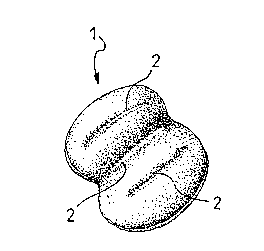Une partie des informations de ce site Web a été fournie par des sources externes. Le gouvernement du Canada n'assume aucune responsabilité concernant la précision, l'actualité ou la fiabilité des informations fournies par les sources externes. Les utilisateurs qui désirent employer cette information devraient consulter directement la source des informations. Le contenu fourni par les sources externes n'est pas assujetti aux exigences sur les langues officielles, la protection des renseignements personnels et l'accessibilité.
L'apparition de différences dans le texte et l'image des Revendications et de l'Abrégé dépend du moment auquel le document est publié. Les textes des Revendications et de l'Abrégé sont affichés :
| (12) Brevet: | (11) CA 2052361 |
|---|---|
| (54) Titre français: | BISCOTTE AU GOUT DE PAIN ET METHODE DE FABRICATION |
| (54) Titre anglais: | CRACKER TASTING BREAD-LIKE AND METHOD OF MAKING THE SAME |
| Statut: | Durée expirée - au-delà du délai suivant l'octroi |
| (51) Classification internationale des brevets (CIB): |
|
|---|---|
| (72) Inventeurs : |
|
| (73) Titulaires : |
|
| (71) Demandeurs : | |
| (74) Agent: | OYEN WIGGS GREEN & MUTALA LLP |
| (74) Co-agent: | |
| (45) Délivré: | 1998-05-05 |
| (22) Date de dépôt: | 1991-09-27 |
| (41) Mise à la disponibilité du public: | 1993-03-28 |
| Requête d'examen: | 1994-11-15 |
| Licence disponible: | S.O. |
| Cédé au domaine public: | S.O. |
| (25) Langue des documents déposés: | Anglais |
| Traité de coopération en matière de brevets (PCT): | Non |
|---|
| (30) Données de priorité de la demande: | S.O. |
|---|
Craquelin à saveur de pain formé à partir d'une pâte à craquelins contenant une suspension aqueuse d'un mélange de farine et de levure, ainsi qu'un mélange fermenté constitué de farine et de levure.
A cracker having a bread-like taste is formed
from a dough for crackers which incorporates an aqueous
suspension of a mixture of flour and yeast and a fermented
mixture comprising flour and yeast.
Note : Les revendications sont présentées dans la langue officielle dans laquelle elles ont été soumises.
Note : Les descriptions sont présentées dans la langue officielle dans laquelle elles ont été soumises.

2024-08-01 : Dans le cadre de la transition vers les Brevets de nouvelle génération (BNG), la base de données sur les brevets canadiens (BDBC) contient désormais un Historique d'événement plus détaillé, qui reproduit le Journal des événements de notre nouvelle solution interne.
Veuillez noter que les événements débutant par « Inactive : » se réfèrent à des événements qui ne sont plus utilisés dans notre nouvelle solution interne.
Pour une meilleure compréhension de l'état de la demande ou brevet qui figure sur cette page, la rubrique Mise en garde , et les descriptions de Brevet , Historique d'événement , Taxes périodiques et Historique des paiements devraient être consultées.
| Description | Date |
|---|---|
| Inactive : CIB expirée | 2016-01-01 |
| Inactive : Périmé (brevet - nouvelle loi) | 2011-09-27 |
| Accordé par délivrance | 1998-05-05 |
| Inactive : Taxe finale reçue | 1998-01-07 |
| Préoctroi | 1998-01-07 |
| Inactive : Pages reçues à l'acceptation | 1998-01-07 |
| Un avis d'acceptation est envoyé | 1997-10-27 |
| Un avis d'acceptation est envoyé | 1997-10-27 |
| Lettre envoyée | 1997-10-27 |
| Inactive : Dem. traitée sur TS dès date d'ent. journal | 1997-10-21 |
| Inactive : Renseign. sur l'état - Complets dès date d'ent. journ. | 1997-10-21 |
| Inactive : CIB en 1re position | 1997-08-14 |
| Inactive : CIB enlevée | 1997-08-14 |
| Inactive : CIB attribuée | 1997-08-14 |
| Inactive : Approuvée aux fins d'acceptation (AFA) | 1997-08-14 |
| Exigences pour une requête d'examen - jugée conforme | 1994-11-15 |
| Toutes les exigences pour l'examen - jugée conforme | 1994-11-15 |
| Demande publiée (accessible au public) | 1993-03-28 |
Il n'y a pas d'historique d'abandonnement
Le dernier paiement a été reçu le
Avis : Si le paiement en totalité n'a pas été reçu au plus tard à la date indiquée, une taxe supplémentaire peut être imposée, soit une des taxes suivantes :
Veuillez vous référer à la page web des taxes sur les brevets de l'OPIC pour voir tous les montants actuels des taxes.
| Type de taxes | Anniversaire | Échéance | Date payée |
|---|---|---|---|
| TM (demande, 6e anniv.) - générale | 06 | 1997-09-29 | 1997-08-20 |
| Taxe finale - générale | 1998-01-07 | ||
| TM (brevet, 7e anniv.) - générale | 1998-09-28 | 1998-08-12 | |
| TM (brevet, 8e anniv.) - générale | 1999-09-27 | 1999-08-11 | |
| TM (brevet, 9e anniv.) - générale | 2000-09-27 | 2000-08-09 | |
| TM (brevet, 10e anniv.) - générale | 2001-09-27 | 2001-08-27 | |
| TM (brevet, 11e anniv.) - générale | 2002-09-27 | 2002-08-28 | |
| TM (brevet, 12e anniv.) - générale | 2003-09-29 | 2003-08-27 | |
| TM (brevet, 13e anniv.) - générale | 2004-09-27 | 2004-08-26 | |
| TM (brevet, 14e anniv.) - générale | 2005-09-27 | 2005-08-25 | |
| TM (brevet, 15e anniv.) - générale | 2006-09-27 | 2006-08-28 | |
| TM (brevet, 16e anniv.) - générale | 2007-09-27 | 2007-09-24 | |
| TM (brevet, 17e anniv.) - générale | 2008-09-29 | 2008-09-04 | |
| TM (brevet, 18e anniv.) - générale | 2009-09-28 | 2009-09-22 | |
| TM (brevet, 19e anniv.) - générale | 2010-09-27 | 2010-09-22 | |
| TM (demande, 2e anniv.) - générale | 02 | 1993-09-27 |
Les titulaires actuels et antérieures au dossier sont affichés en ordre alphabétique.
| Titulaires actuels au dossier |
|---|
| BARILLA G. E R. F. LLI - SOCIETA PER AZIONI |
| Titulaires antérieures au dossier |
|---|
| NOEL HAEGENS |
| ROMEO SIGNANI |
| STEFANO RIGHI |